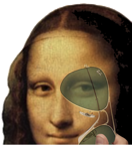 First you need to get a pair of sunglasses and hold one glass over one eye, like in the image on the left. Then look with both eyes open at the top animation. It may take a while, but you should see suddenly depth in three layers: all dots moving rapidly to the right are in one layer (e.g. near), the slow dots form another layer, and the fast dots moving to the left form a third depth layer (e.g. far).
First you need to get a pair of sunglasses and hold one glass over one eye, like in the image on the left. Then look with both eyes open at the top animation. It may take a while, but you should see suddenly depth in three layers: all dots moving rapidly to the right are in one layer (e.g. near), the slow dots form another layer, and the fast dots moving to the left form a third depth layer (e.g. far).
You can experiment by switching the glass to the other eye: when the glass is in front of the right eye, the right-moving dots should be close to you. Dark glass on the left eye: the right-moving dots should form the more distant layer. Changing the speed within sensible limits: slower speed = less depth, more speed = more depth.
BTW: both the slow downward motion and the colours are just eye candy and not necessary for the Pulfrich effect.
There are many explanations for this on the web, so I can be brief. Basically, the reduced luminance in the covered eye entails slower processing in the photoreceptors, following the rule “10× darker ≈ 10 ms slower”. Thus in the covered eye the perceived position lags a little behind. Differences in position between the eyes in corresponding retinal locations are interpreted in our brain as different depth, because that’s exactly what happens if objects really are at different distances from us → stereovision, now widely known via 3D movies.
Some people see the depth layers even w/o a darkening filter. This happens for instance when you have different size pupils (“anisocoria”). The Pulfrich effect has also been employed by doctors to help diagnosing inflammatory diseases of the optic nerve, inflammation slows down conduction speed.
Interestingly, the physicist Pulfrich was blind on his left eye, and thus never saw this effect himself! Rather, he theoretically deduced it (with Fertsch) to explain systematic errors that occurred when stereo images (e.g. taken from airplanes) were manually analysed in “stereocomparators” to produce topographic maps at Zeiss.
For demonstration of the Pulfrich phenomenon, typically a pendulum is employed. That’s what I used yesterday in my “emeriting lecture” at my university but found the effect to be unreliable: It’s difficult to have the pendulum really swing in a plane and not in an ellipsis by itself, so one needs to employ a double string, which is difficult to mount in a lecture hall. So, taking a hint from Blelb, I programmed the present demonstration.
About 25 years ago, the Pulfrich effect caused a brief rage in entertainment (TV etc.), where it was claimed it could add depth to a moving scene. Special glasses wer sold (glorified single-eyes sunglasses) and special programs produced. The problem is, of course, that motion direction and depth are always entangled! So whatever moves to the right is closer to you, what moves left is more distant – or the other way round, depending on which eye wears the dark filter. So a carousel would be fine, if it rotated in the right direction. For general scenes, the entanglement of motion direction and distance is not acceptable, of course, so the rage died rapidly…
Pulfrich 1922 – Scans of the original paper and more
Christianson S, Hofstetter HW (1972) Some Historical Notes on Carl Pulfrich. Am J Optomet Arch Am Acad Optomet 49:944–947